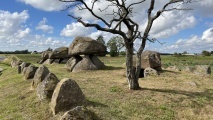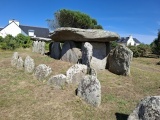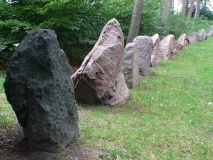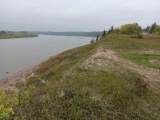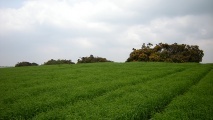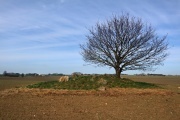Andy Burnham's Blog, page 9
September 9, 2025
Stenbjerggård Langdysse
Langdysse (Long Barrow) in Svendborg. There are 5 chambers on this monument. Four are more or less in line, the eastern one is located to the north of that line. Easy to find on road 323 from Orbaek to Ringe. You can park your car on the side of the road.
Published on September 09, 2025 01:25
September 7, 2025
Pors Poulhan allée couverte
On a headland overlooking the Baie D'Audierne, this allée couverte is in a tremendous position. Excavations have shown it to have not only been constructed and used by neolithic flint workers, but also for burials in the bronze age, iron age, and by the Gallo-Romans. In the middle ages it was used as a quarry for building stone, - since then it has been used as a military look out post, and as such was blown up during the second world war. Fortunately it was restored in 1990.
Published on September 07, 2025 07:38
Menhir de Lestrouguy
A menhir in the flower bed of a private garden. On the D2 road , half way between Plozevet and Pouldreuzic.
Published on September 07, 2025 07:34
September 5, 2025
Glavendruplunden
A site on the Danish island of Fyn (Funen) with monuments from many time periods: two prehistoric barrows, a stone ship setting from the early 900s, a large Viking Age monolith, which bears Denmark's longest inscription on a rune stone, and more recent additions.
Published on September 05, 2025 05:14
September 3, 2025
Âsowanânihk Ancient Indigenous Site
A small landslide along the East Saskatchewan River revealed evidence of a 10,700 year old ancient indigenous site. There was a recent excavation as it was under threat. Evidence suggests the site was a long-term settlement rather than a temporary hunting camp. Findings include stone tools, fire pits, and lithic materials used in toolmaking. Charcoal layers indicate early Indigenous inhabitants practiced fire management, aligning with longstanding oral traditions. The discovery of large bison remains provides insight into early hunting techniques and the evolution of the species. Despite its immense significance, the site faces threats from logging and industrial activity.
Published on September 03, 2025 09:40
Colossi of Memnon
The two colossal statues of Amenhotep III, originally 21 metres tall have stood in this location since 1350 BCE. The site became legendary for divination after one of the statues began making noises interpreted as oracles. The Greek historian Strabo (65 BCE-23 CE) was the first to record the sound which would later be described as singing, the sound of a lyre, brass instruments, a broken harp or lyre string, and a slap or blow. We have hundreds more ancient Egyptian sites plotted on our interactive map, explore via this page
Published on September 03, 2025 03:59
Mesa Verde - Mesa Top Sites
Video commentaries by Stonetracker for this site in the comments on our page. On a short trail from a parking pulloff on the Mesa Top loop drive, illustrates the evolution of three Ancestral Pueblo villages and architectural styles spanning the period 900-1075 CE. Each village either overlaps or is built on top of the preceding village. It also highlights the challenge archaeologists often face when distinguishing one architectural period from another. The kiva was a vital part of all three villages, gradually evolving into what archaeologists refer to as the Mesa Verde-style kiva.
Published on September 03, 2025 03:23
West Taphouse Barrow Cemetery (B)
A group 4 barrows the tallest of which is 4m high. The barrows are now covered with trees and shrubs which the LiDAR image here strips away. Aligned roughly east west on Taphouse ridge with wonderful views of this part of Cornwall.
Published on September 03, 2025 03:18
September 2, 2025
St Brandon’s Church, Brancepeth
This church suffered from a devastating fire in 1998. An archaeological survey after the fire indicated that there was a Saxon building on the site of the present church building which itself was established in the 12th century. During restoration 100 medieval tombstones dating from 1300-1500 were discovered hidden in the walls. Some of the symbols carved into them are unique to this church and are known as the ‘Brancepeth Code’. Photos of these on our page.
Published on September 02, 2025 05:38
Sigersted Runddysse 2
Published on September 02, 2025 05:32

